Novel Aminosilane (APTES)-Grafted Polyaniline@Graphene Oxide (PANI-GO) Nanocomposite for Electrochemical Sensor
Abstract
1. Introduction
2. Materials and Methodology
2.1. Reagents
2.2. Instrumentation
2.3. Procedure for Preparation of Polyaniline (PANI)
2.4. Procedure for Preparation of GO-APTES
2.5. Introduction of PANI Matrix into GO-APTES Composite
2.6. Characterization of the Synthesized Sample (PANI-GO-APTES)
2.7. Electrochemical Detection of Lead (II) Ions
2.8. Fabrication of Pb2+ Electrochemical Sensor Probe
3. Results and Discussions
3.1. Results of Characterization
3.1.1. Morphological Investigation
3.1.2. Elemental Composition Investigation with XEDS and XPS
3.1.3. Structural Investigation
3.1.4. FTIR Analysis
3.1.5. Thermal Stability Investigation
3.1.6. Electrochemical Impedance Spectroscopy (EIS)
3.1.7. Electrical Conductivity Using Four-Probe Method
3.2. Application of PANI-GO-APTES as Sensor for Pb2+ in Aqueous Solution
3.2.1. Selectivity
3.2.2. Control Experiment
3.2.3. Influence of pH of Supporting Electrolyte
3.2.4. Influence of Scan Rate
3.3. Influence of Varying Pb2+ Concentration
3.4. Analytical Performance of PANI-GO-APTES in the Detection of Pb2+
3.4.1. Parameters of Merit
3.4.2. Sensor’s Stability
3.5. Application of the Proposed Sensor Based on PANI-GO-APTES for Real Sample Analysis
3.6. Performance Comparison with Previous Work
4. Conclusions
Supplementary Materials
Author Contributions
Funding
Acknowledgments
Conflicts of Interest
References
- Khan, A.; Khan, A.A.P.; Asiri, A.M.; Gupta, V.; Rathore, M. Preparation, properties and applications of organic–inorganic hybrid nanocomposite poly(aniline-co-o-toluidine) tungstomolybdate. J. Mol. Liq. 2016, 216, 646–653. [Google Scholar] [CrossRef]
- Usuki, A.; Kojima, Y.; Kawasumi, M.; Okada, A.; Fukushima, Y.; Kurauchi, T.; Kamigaito, O. Synthesis of nylon 6-clay hybrid. J. Mater. Res. 1993, 8, 1179–1184. [Google Scholar] [CrossRef]
- Al Zoubi, W.; Kamil, M.P.; Fatimah, S.; Nashrah, N.; Ko, Y.G. Recent advances in hybrid organic-inorganic materials with spatial architecture for state-of-the-art applications. Prog. Mater. Sci. 2020, 112, 100663. [Google Scholar] [CrossRef]
- Lee, B.H.; Yoon, B.; Abdulagatov, A.I.; Hall, R.A.; George, S.M. Growth and Properties of Hybrid Organic-Inorganic Metalcone Films Using Molecular Layer Deposition Techniques. Adv. Funct. Mater. 2013, 23, 532–546. [Google Scholar] [CrossRef]
- Meng, X. An overview of molecular layer deposition for organic and organic–inorganic hybrid materials: Mechanisms growth characteristics and promising applications. J. Mater. Chem. A 2017, 5, 18326–18378. [Google Scholar] [CrossRef]
- Gogoi, K.K.; Chowdhury, A. Performance Enhancement of Solution-Processed Organic Memories by Exploiting Synergistic Organic–Inorganic Hybrid Composites. J. Phys. Chem. C 2020, 124, 1108–1120. [Google Scholar] [CrossRef]
- Ul Haque, S.; Nasar, A.; Rahman, M.M. Applications of chitosan (CHI)-reduced graphene oxide (rGO)-polyaniline (PAni) conducting composite electrode for energy generation in glucose biofuel cell. Sci. Rep. 2020, 10, 1–13. [Google Scholar] [CrossRef]
- Ke, F.; Liu, Y.; Xu, H.; Ma, Y.; Guang, S.; Zhang, F.; Lin, N.; Ye, M.; Lin, Y.; Liu, X. Flower-like polyaniline/graphene hybrids for high-performance supercapacitor. Compos. Sci. Technol. 2017, 142, 286–293. [Google Scholar] [CrossRef]
- Gahlot, S.; Kulshrestha, V. Graphene based polymer electrolyte membranes for electro-chemical energy applications. Int. J. Hydrogen Energy 2020, 45, 17029–17056. [Google Scholar] [CrossRef]
- Tiwari, S.; Purabgola, A.; Kandasubramanian, B. Functionalised graphene as flexible electrodes for polymer photovoltaics. J. Alloys Compd. 2020, 825, 153954. [Google Scholar] [CrossRef]
- Bonaccorso, F.; Sun, Z.; Hasan, T.; Ferrari, A.C. Graphene photonics and optoelectronics. Nat. Photonics 2010, 4, 611–622. [Google Scholar] [CrossRef]
- Bouville, F.; Maire, E.; Meille, S.; Van de Moortèle, B.; Stevenson, A.J.; Deville, S. Strong, tough and stiff bioinspired ceramics from brittle constituents. Nat. Mater. 2014, 13, 508–514. [Google Scholar] [CrossRef] [PubMed]
- Khan, A.; Parwaz Khan, A.A.; Khan, I.; Oves, M.; Khan, S.; Asiri, A.M.; Azum, N.; Taib, L.A.; Al Angari, Y.M.; Facchetti, A. Facial synthesis of highly active polymer vanadium molybdate nanocomposite: Improved thermoelectric and antimicrobial studies. J. Phys. Chem. Solids 2019, 131, 148–155. [Google Scholar] [CrossRef]
- Lingamdinne, L.P.; Koduru, J.R.; Karri, R.R. A comprehensive review of applications of magnetic graphene oxide based nanocomposites for sustainable water purification. J. Environ. Manag. 2019, 231, 622–634. [Google Scholar] [CrossRef] [PubMed]
- Haque, S.U.; Nasar, A.; Asiri, A.M. Preparation and characterization of a bioanode (GC/MnO 2 /PSS/Gph/Frt/GOx) for biofuel cell application. Int. J. Hydrogen Energy 2019, 44, 7308–7319. [Google Scholar] [CrossRef]
- Han, Y.; Qian, C.; Wu, H.; Chen, X.; Wu, X.; He, W.; Yan, H.; Li, G.; Diao, G.; Chen, M. Two flowers per seed: Derivatives of CoG@F127/GO with enhanced catalytic performance of overall water splitting. J. Energy Chem. 2021, 54, 761–769. [Google Scholar] [CrossRef]
- Sonawane, S.; Thakur, P.; Paul, R. Study on thermal property enhancement of MWCNT based polypropylene (PP) nanocomposites. Mater. Today Proc. 2020, 27, 550–555. [Google Scholar] [CrossRef]
- Peng, B.; Takai, C.; Razavi-khosroshahi, H.; Fuji, M. Effect of silane modification on CNTs/silica composites fabricated by a non-firing process to enhance interfacial property and dispersibility. Adv. Powder Technol. 2018, 29, 2091–2096. [Google Scholar] [CrossRef]
- Zhi, X.; Mao, Y.; Yu, Z.; Wen, S.; Li, Y.; Zhang, L.; Chan, T.W.; Liu, L. γ-Aminopropyl triethoxysilane functionalized graphene oxide for composites with high dielectric constant and low dielectric loss. Compos. Part A Appl. Sci. Manuf. 2015, 76, 194–202. [Google Scholar] [CrossRef]
- Frank, J.J.; Poulakos, A.G.; Tornero-Velez, R.; Xue, J. Systematic review and meta-analyses of lead (Pb) concentrations in environmental media (soil, dust, water, food, and air) reported in the United States from 1996 to 2016. Sci. Total Environ. 2019, 694, 133489. [Google Scholar] [CrossRef]
- Li, C.-L.; Liu, K.-T.; Lin, Y.-W.; Chang, H.-T. Fluorescence Detection of Lead(II) Ions Through Their Induced Catalytic Activity of DNAzymes. Anal. Chem. 2011, 83, 225–230. [Google Scholar] [CrossRef]
- Yan, M.; Zhu, C.; Huang, Y.; Yan, J.; Chen, A. Ultrasensitive detection of lead(II) using a turn-on probe based on the use of an aptamer and a water-soluble fluorescent perylene probe. Microchim. Acta 2017, 184, 2439–2444. [Google Scholar] [CrossRef]
- Sivasubramanian, R.; Sangaranarayanan, M. V Detection of lead ions in picomolar concentration range using underpotential deposition on silver nanoparticles-deposited glassy carbon electrodes. Talanta 2011, 85, 2142–2147. [Google Scholar] [CrossRef] [PubMed]
- Liu, W.-Y.; Ju, X.-J.; Faraj, Y.; He, F.; Peng, H.-Y.; Liu, Y.-Q.; Liu, Z.; Wang, W.; Xie, R.; Chu, L.-Y. Capsule membranes encapsulated with smart nanogels for facile detection of trace lead(II) ions in water. J. Membr. Sci. 2020, 613, 118523. [Google Scholar] [CrossRef]
- Duong, T.D.S.; Jang, C.-H. A label-free liquid crystal droplet-based sensor used to detect lead ions using single-stranded DNAzyme. Colloids Surf. A Physicochem. Eng. Asp. 2020, 604, 125304. [Google Scholar] [CrossRef]
- Chu, J.; Chen, C.; Li, X.; Yu, L.; Li, W.; Cheng, M.; Tang, W.; Xiong, Z. A responsive pure DNA hydrogel for label-free detection of lead ion. Anal. Chim. Acta 2021, 1157, 338400. [Google Scholar] [CrossRef]
- Chabbah, T.; Abderrazak, H.; Souissi, R.; Saint-Martin, P.; Casabianca, H.; Chatti, S.; Mercier, R.; Rassas, I.; Errachid, A.; Hammami, M.; et al. A Sensitive Impedimetric Sensor Based on Biosourced Polyphosphine Films for the Detection of Lead Ions. Chemosensors 2020, 8, 34. [Google Scholar] [CrossRef]
- Kim, R.; Youn, Y.-S.; Kang, M.; Kim, E. Platform- and label-free detection of lead ions in environmental and laboratory samples using G-quadraplex probes by circular dichroism spectroscopy. Sci. Rep. 2020, 10, 20461. [Google Scholar] [CrossRef]
- Chen, G.; Bai, W.; Jin, Y.; Zheng, J. Fluorescence and electrochemical assay for bimodal detection of lead ions based on Metal–Organic framework nanosheets. Talanta 2021, 232, 122405. [Google Scholar] [CrossRef]
- Martín-Yerga, D.; Álvarez-Martos, I.; Blanco-López, M.C.; Henry, C.S.; Fernández-Abedul, M.T. Point-of-need simultaneous electrochemical detection of lead and cadmium using low-cost stencil-printed transparency electrodes. Anal. Chim. Acta 2017, 981, 24–33. [Google Scholar] [CrossRef]
- Baghayeri, M.; Ghanei-Motlagh, M.; Tayebee, R.; Fayazi, M.; Narenji, F. Application of graphene/zinc-based metal-organic framework nanocomposite for electrochemical sensing of As(III) in water resources. Anal. Chim. Acta 2020, 1099, 60–67. [Google Scholar] [CrossRef]
- Wei, P.; Zhu, Z.; Song, R.; Li, Z.; Chen, C. An ion-imprinted sensor based on chitosan-graphene oxide composite polymer modified glassy carbon electrode for environmental sensing application. Electrochim. Acta 2019, 317, 93–101. [Google Scholar] [CrossRef]
- Sreenivasa Rao, K.; Balaji, T.; Prasada Rao, T.; Babu, Y.; Naidu, G.R.K. Determination of iron, cobalt, nickel, manganese, zinc, copper, cadmium and lead in human hair by inductively coupled plasma-atomic emission spectrometry. Spectrochim. Acta Part B At. Spectrosc. 2002, 57, 1333–1338. [Google Scholar] [CrossRef]
- Daşbaşı, T.; Saçmacı, Ş.; Çankaya, N.; Soykan, C. A new synthesis, characterization and application chelating resin for determination of some trace metals in honey samples by FAAS. Food Chem. 2016, 203, 283–291. [Google Scholar] [CrossRef]
- Munir, A.; Shah, A.; Nisar, J.; Ashiq, M.N.; Akhter, M.S.; Shah, A.H. Selective and simultaneous detection of Zn2+, Cd2+, Pb2+, Cu2+, Hg2+ and Sr2+ using surfactant modified electrochemical sensors. Electrochim. Acta 2019, 323, 134592. [Google Scholar] [CrossRef]
- Rahman, N.H.B.T.; Tee, T.W.; Sirat, K. Adsorption enhancement of Pb(II) ion in the presence of Nicotinic acid during cyclic Voltammetry. Int. J. Electrochem. Sci. 2011, 6, 3118–3128. [Google Scholar]
- Riyanto, D. Determination of lead in waste water using cyclic voltammetry by platinum wire electrode. Eksakta J. Ilmu-Ilmu MIPA 2015, 14, 22–33. [Google Scholar] [CrossRef][Green Version]
- Magerusan, L.; Socaci, C.; Coros, M.; Pogacean, F.; Rosu, M.C.; Gergely, S.; Pruneanu, S.; Leostean, C.; Pana, I.O. Electrochemical platform based on nitrogen-doped graphene/chitosan nanocomposite for selective Pb2+ detection. Nanotechnology 2017, 28. [Google Scholar] [CrossRef]
- Anambiga, I.V.; Suganthan, V.; Raj, N.A.N.; Kumar, A.S. Electrochemical sensor for the detection of lead ions. In Proceedings of the International Conference on Advanced Nanomaterials and Emerging Engineering Technologies, Chennai, India, 24–26 July 2013; pp. 367–370. [Google Scholar]
- Ibrahim, N.I.; Wasfi, A.S. A comparative study of polyaniline/MWCNT with polyaniline/SWCNT nanocomposite films synthesized by microwave plasma polymerization. Synth. Met. 2019, 250, 49–54. [Google Scholar] [CrossRef]
- Huang, J.; Ding, S.; Xiao, W.; Peng, Y.; Deng, S.; Zhang, N. 3-Aminopropyl-triethoxysilane functionalized graphene oxide: A highly efficient and recyclable catalyst for knoevenagel condensation. Catal. Lett. 2015, 145, 1000–1007. [Google Scholar] [CrossRef]
- Yan, S.; Yang, Y.; Song, L.; Qi, X.; Xue, Y.; Fan, B. Influence of 3-aminopropyltriethoxysilane- graphite oxide composite on thermal stability and mechanical property of polyethersulfone. High Perform. Polym. 2017, 29, 960–975. [Google Scholar] [CrossRef]
- Ma, W.; Wu, L.; Zhang, D.; Wang, S. Preparation and properties of 3-aminopropyltriethoxysilane functionalized graphene/polyurethane nanocomposite coatings. Colloid Polym. Sci. 2013, 291, 2765–2773. [Google Scholar] [CrossRef]
- Etemadi, M.; Samadi, S.; Yazd, S.S.; Jafari, P.; Yousefi, N.; Aliabadi, M. Selective adsorption of Cr(VI) ions from aqueous solutions using Cr6+-imprinted Pebax/chitosan/GO/APTES nanofibrous adsorbent. Int. J. Biol. Macromol. 2017, 95, 725–733. [Google Scholar] [CrossRef] [PubMed]
- Guler, M.; Dilmac, Y. Palladium nanoparticles decorated (3-aminopropyl)triethoxysilane functionalized reduced graphene oxide for electrochemical determination of glucose and hydrogen peroxide. J. Electroanal. Chem. 2019, 834, 49–55. [Google Scholar] [CrossRef]
- Abu-Zied, B.M.; Hussein, M.A.; Khan, A.; Asiri, A.M. Cu-Cu2O@graphene nanoplatelets nanocomposites: Facile synthesis, characterization, and electrical conductivity properties. Mater. Chem. Phys. 2018, 213, 168–176. [Google Scholar] [CrossRef]
- Ourari, A.; Zerdoumi, R.; Ruiz-Rosas, R.; Morallon, E. Synthesis and catalytic properties of modified electrodes by pulsed electrodeposition of Pt/PANI nanocomposite. Materials 2019, 12, 723. [Google Scholar] [CrossRef] [PubMed]
- Mozafari, V.; Parsa, J.B. Electrochemical synthesis of Pd supported on PANI-MWCNTs-SnO2 nanocomposite as a novel catalyst towards ethanol oxidation in alkaline media. Synth. Met. 2020, 259, 116214. [Google Scholar] [CrossRef]
- Soleimani-Lashkenari, M.; Rezaei, S.; Fallah, J.; Rostami, H. Electrocatalytic performance of Pd/PANI/TiO2 nanocomposites for methanol electrooxidation in alkaline media. Synth. Met. 2018, 235, 71–79. [Google Scholar] [CrossRef]
- Adeosun, W.A.; Asiri, A.M.; Marwani, H.M.; Rahman, M.M. Enzymeless Electrocatalytic Detection of Uric Acid Using Polydopamine/Polypyrrole Copolymeric film. Chem. Sel. 2020, 5, 156–164. [Google Scholar] [CrossRef]
- Adeosun, W.A.; Asiri, A.M.; Marwani, H.M. Sensitive determination of 2-nitrophenol using electrochemically deposited polymethyl red film for healthcare and environmental safety. Synth. Met. 2020, 261, 116321. [Google Scholar] [CrossRef]
- Sajjan, V.A.; Aralekallu, S.; Nemakal, M.; Palanna, M.; Prabhu, C.P.K.; Sannegowda, L.K. Nanomolar detection of lead using electrochemical methods based on a novel phthalocyanine. Inorg. Chim. Acta 2020, 506, 119564. [Google Scholar] [CrossRef]
- Veera Manohara Reddy, Y.; Sravani, B.; Łuczak, T.; Mallikarjuna, K.; Madhavi, G. An ultra-sensitive rifampicin electrochemical sensor based on titanium nanoparticles (TiO2) anchored reduced graphene oxide modified glassy carbon electrode. Colloids Surf. A Physicochem. Eng. Asp. 2021, 608, 125533. [Google Scholar] [CrossRef]
- Zhou, S.-F.; Han, X.-J.; Fan, H.-L.; Huang, J.; Liu, Y.-Q. Enhanced electrochemical performance for sensing Pb(II) based on graphene oxide incorporated mesoporous MnFe2O4 nanocomposites. J. Alloys Compd. 2018, 747, 447–454. [Google Scholar] [CrossRef]
- Dutta, S.; Strack, G.; Kurup, P. Gold nanostar electrodes for heavy metal detection. Sens. Actuators B Chem. 2019, 281, 383–391. [Google Scholar] [CrossRef]
- Sang, S.; Li, D.; Zhang, H.; Sun, Y.; Jian, A.; Zhang, Q.; Zhang, W. Facile synthesis of AgNPs on reduced graphene oxide for highly sensitive simultaneous detection of heavy metal ions. RSC Adv. 2017, 7, 21618–21624. [Google Scholar] [CrossRef]
- Pizarro, J.; Segura, R.; Tapia, D.; Bollo, S.; Sierra-Rosales, P. Electroanalytical Determination of Cd(II) and Pb(II) in Bivalve Mollusks using Electrochemically Reduced Graphene Oxide-based Electrode. Electroanalysis 2019, 31, 2199–2205. [Google Scholar] [CrossRef]
- Hu, R.; Zhang, X.; Chi, K.-N.; Yang, T.; Yang, Y.-H. Bifunctional MOFs-Based Ratiometric Electrochemical Sensor for Multiplex Heavy Metal Ions. ACS Appl. Mater. Interfaces 2020, 12, 30770–30778. [Google Scholar] [CrossRef] [PubMed]
- Zhu, X.; Liu, B.; Hou, H.; Huang, Z.; Zeinu, K.M.; Huang, L.; Yuan, X.; Guo, D.; Hu, J.; Yang, J. Alkaline intercalation of Ti3C2 MXene for simultaneous electrochemical detection of Cd(II), Pb(II), Cu(II) and Hg(II). Electrochim. Acta 2017, 248, 46–57. [Google Scholar] [CrossRef]
- Sultan, S.; Shah, A.; Khan, B.; Nisar, J.; Shah, M.R.; Ashiq, M.N.; Akhter, M.S.; Shah, A.H. Calix[4]arene Derivative-Modified Glassy Carbon Electrode: A New Sensing Platform for Rapid, Simultaneous, and Picomolar Detection of Zn(II), Pb(II), As(III), and Hg(II). ACS Omega 2019, 4, 16860–16866. [Google Scholar] [CrossRef]
- Yu, Y.; Naik, S.S.; Oh, Y.; Theerthagiri, J.; Lee, S.J.; Choi, M.Y. Lignin-mediated green synthesis of functionalized gold nanoparticles via pulsed laser technique for selective colorimetric detection of lead ions in aqueous media. J. Hazard. Mater. 2021, 420, 126585. [Google Scholar] [CrossRef] [PubMed]
- Wang, L.; Cao, H.-X.; He, Y.-S.; Pan, C.-G.; Sun, T.-K.; Zhang, X.-Y.; Wang, C.-Y.; Liang, G.-X. Facile preparation of amino-carbon dots/gold nanoclusters FRET ratiometric fluorescent probe for sensing of Pb2+/Cu2+. Sens. Actuators B Chem. 2019, 282, 78–84. [Google Scholar] [CrossRef]
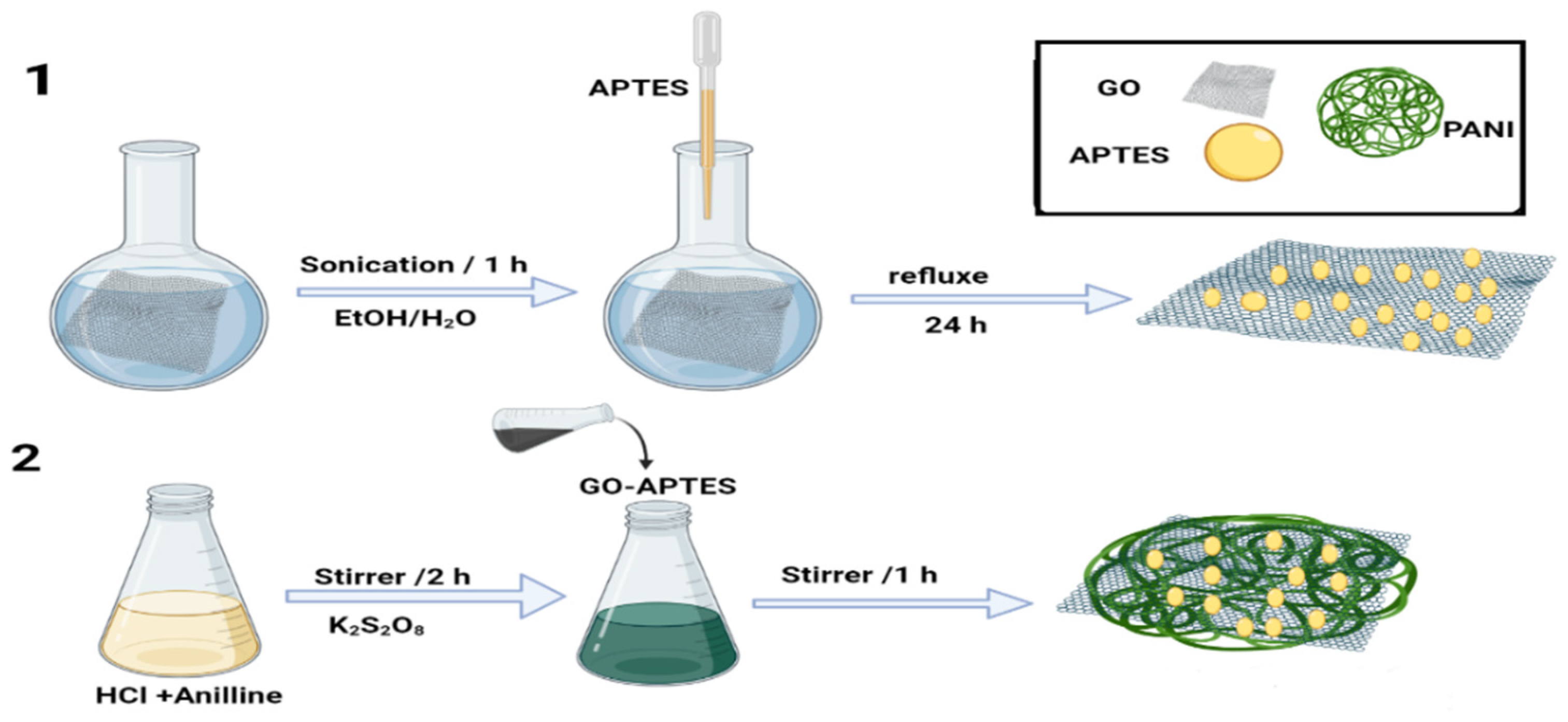
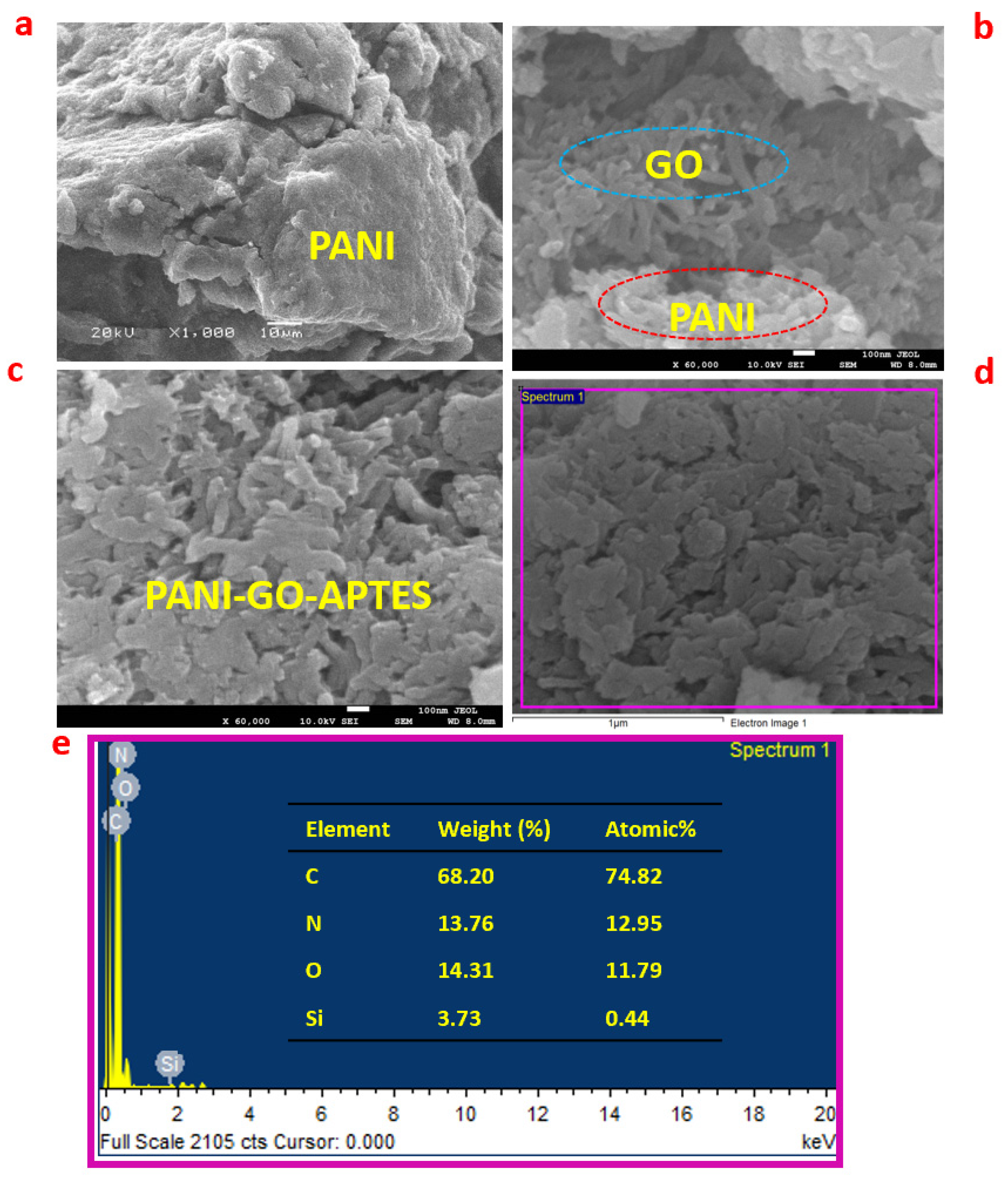
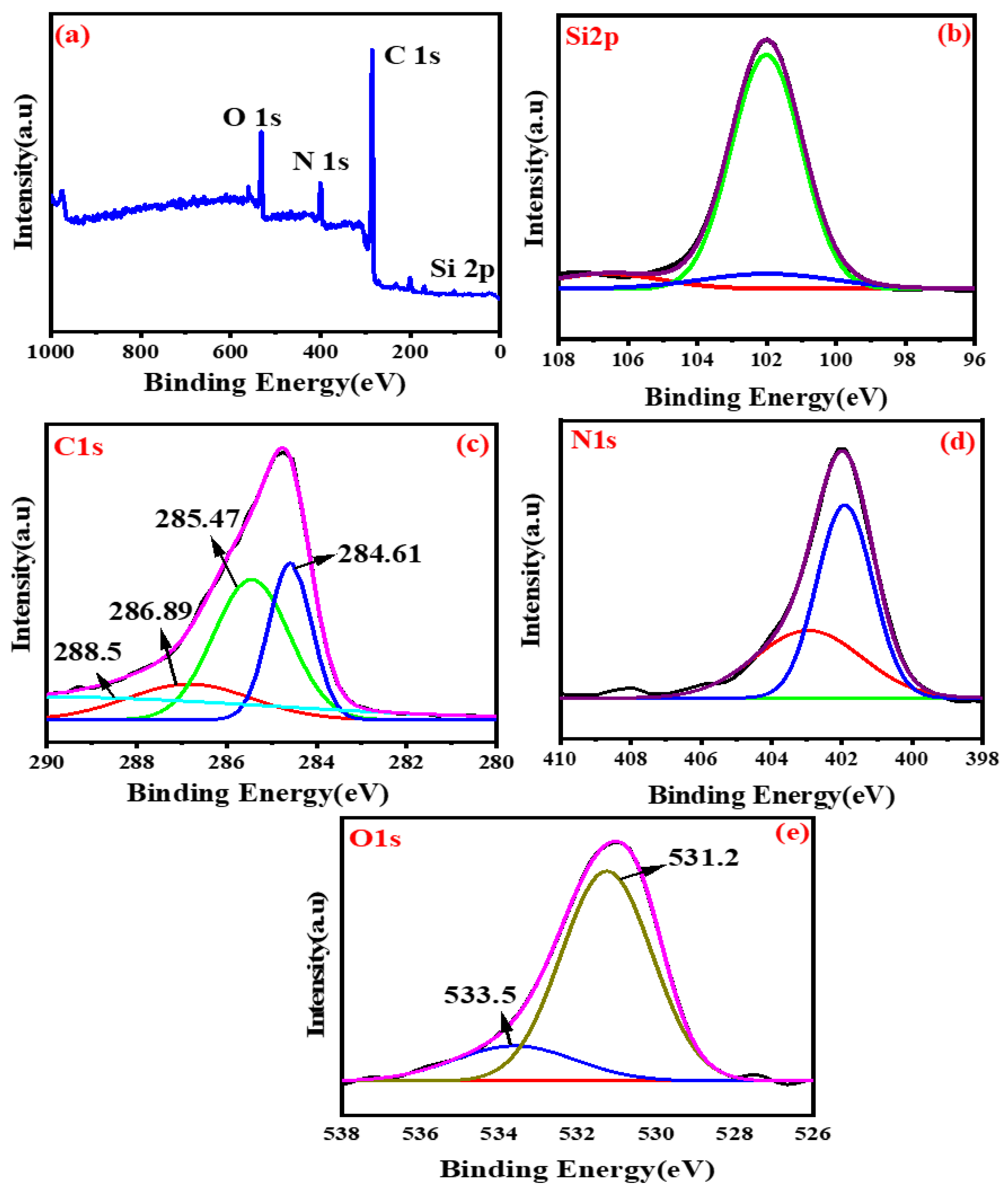
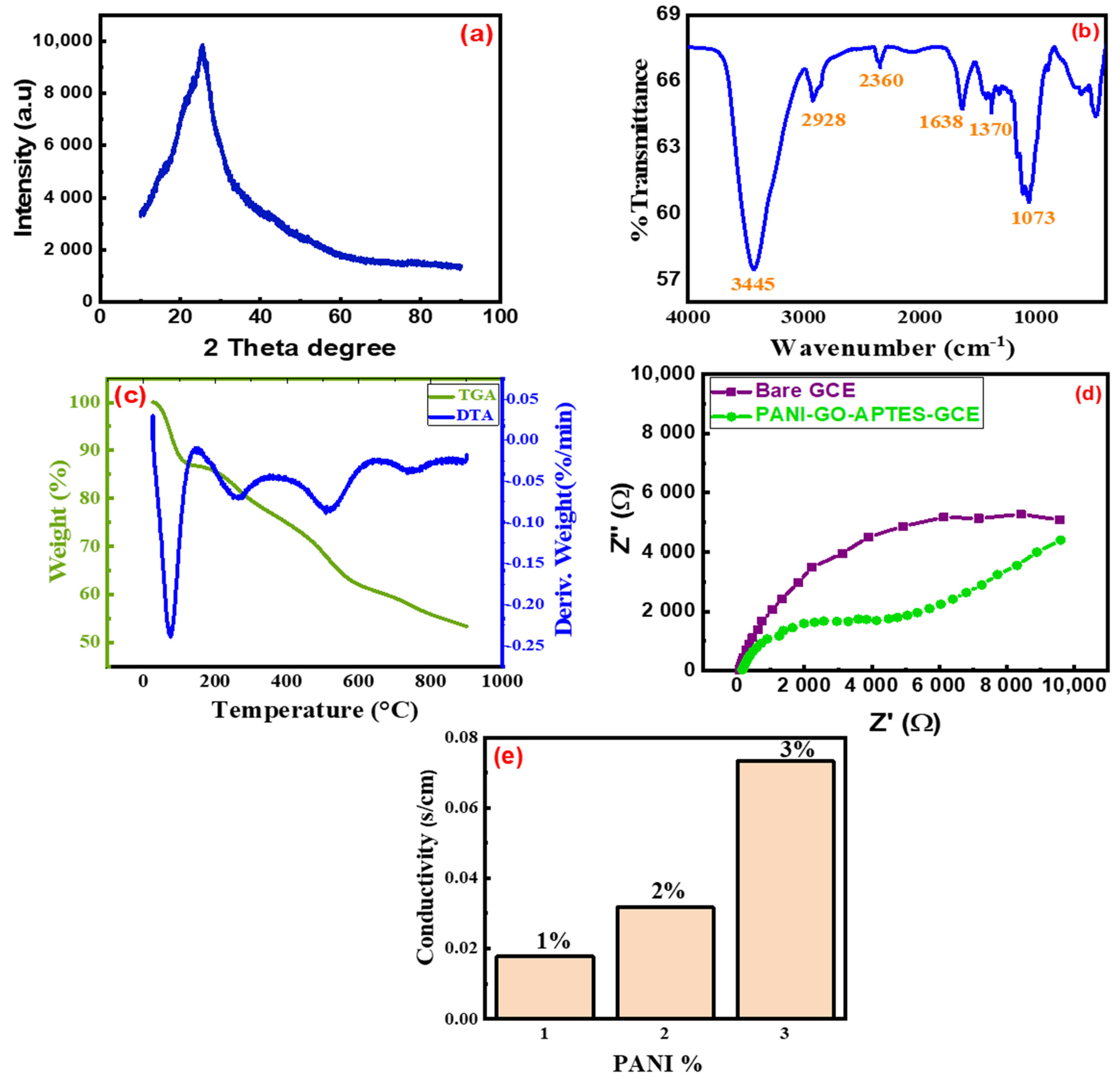
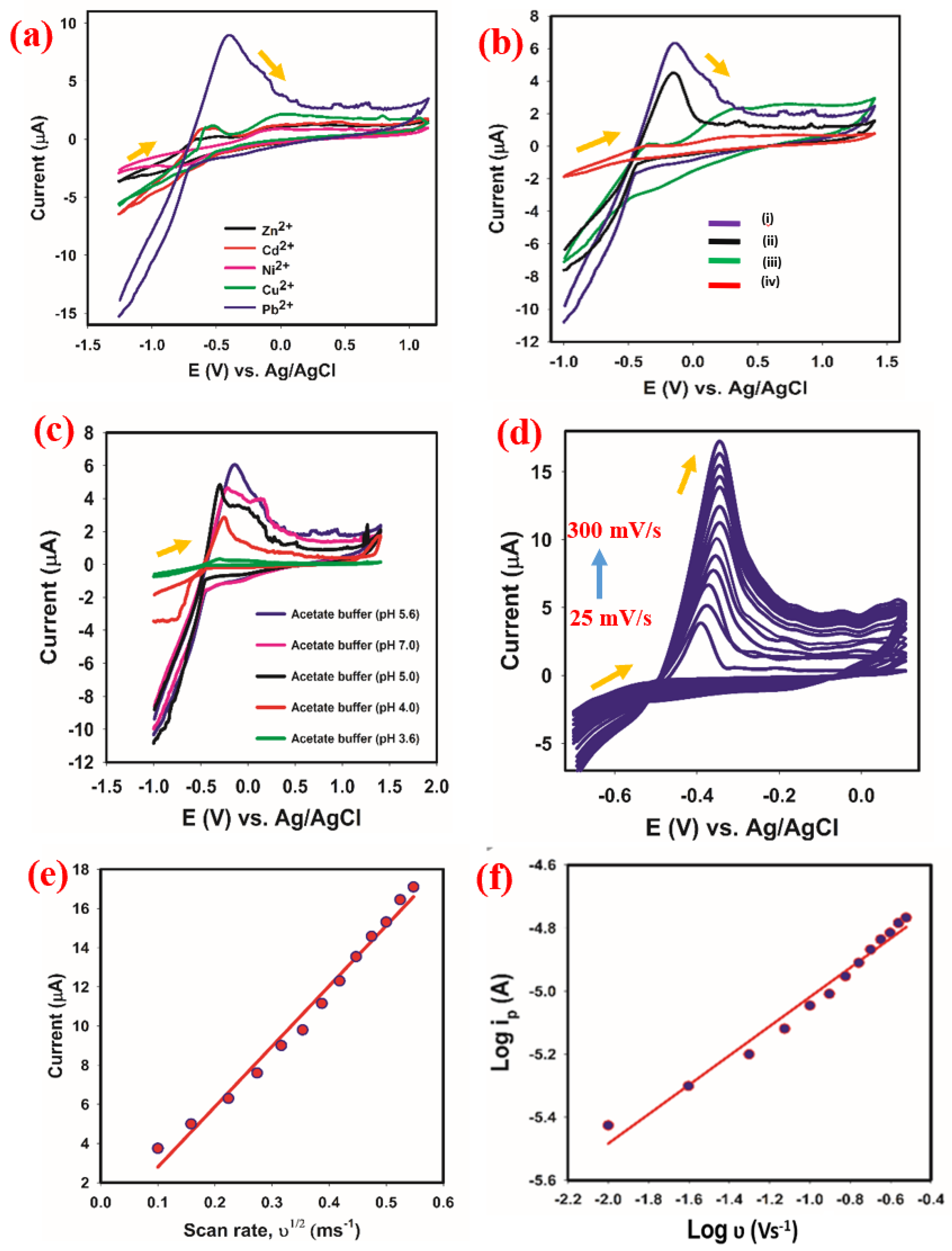
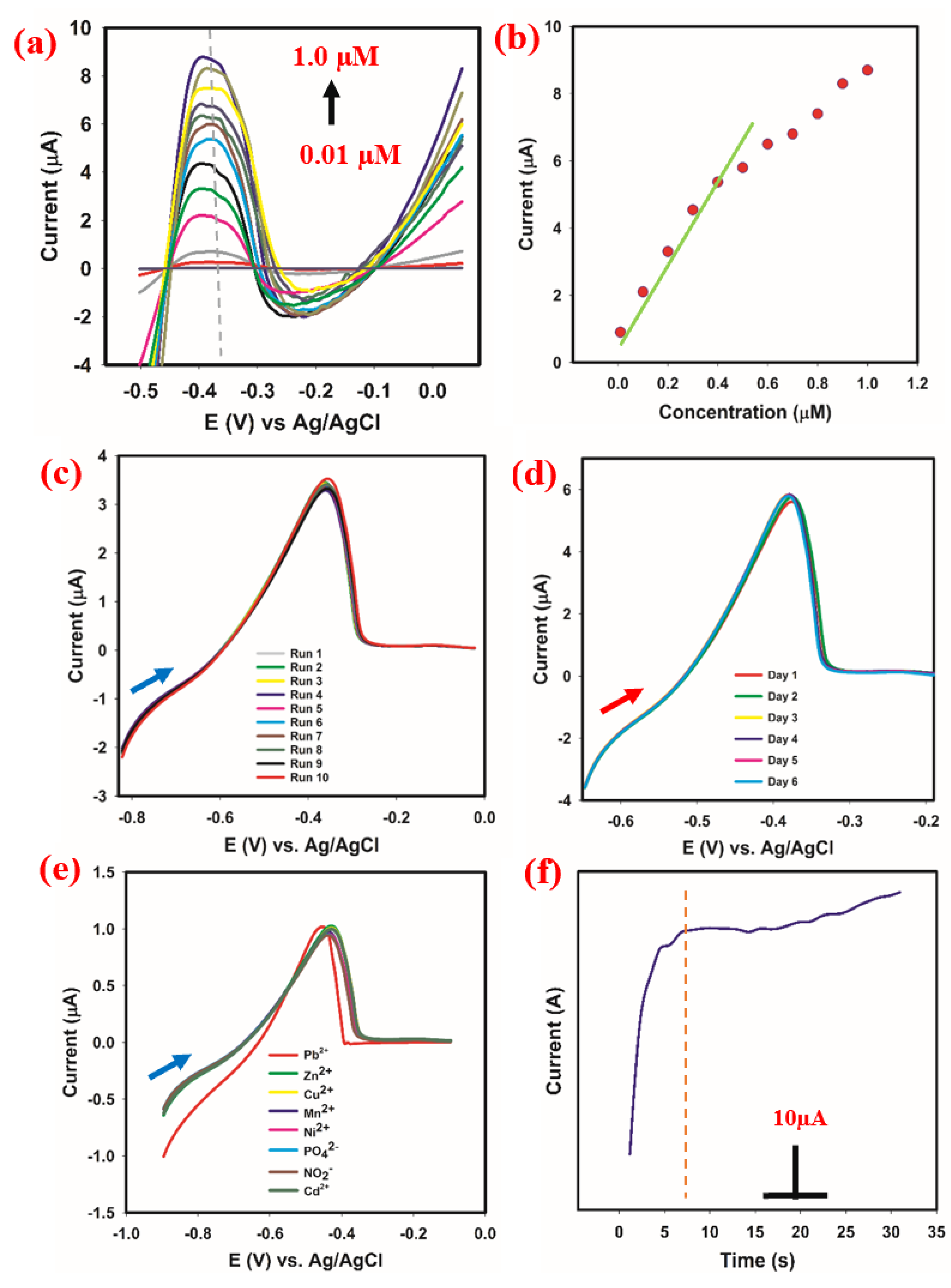
| Sample | NS * | Spiked Concentration (µM) | Found Concentration (µM) | Bias | Recovery (%) | RSD (%) |
|---|---|---|---|---|---|---|
| Tap water | 3 | 0 | 0 | - | - | - |
| 3 | 0.03 | 0.032 + 0.0011 | +0.002 | 106.67% | 3.4 | |
| 3 | 0.2 | 0.19 + 0.017 | −0.01 | 95% | 8.9 | |
| Well water | 3 | 0 | 0 | - | - | - |
| 3 | 0.03 | 0.026 + 0.002 | +0.004 | 86.67% | 7.69 | |
| 3 | 0.2 | 0.206 + 0.003 | +0.006 | 103% | 1.46 | |
| Bottled water | 3 | 0 | 0 | - | - | - |
| 3 | 0.2 | 0.19 + 0.012 | −0.01 | 95% | 6.32 |
| Electrode/Substrate | LDR µM | Method | LOD µM | Ref. |
|---|---|---|---|---|
| GCE/CoTBrImPPc | 0.1–1 | CV | 0.03 | [52] |
| TiO2/rGO/GCE | 1 × 10−5–1 × 10−4 | DPV | 0.03 | [53] |
| MnFe2O4/GO GCE | 0.2–1.1 | SWASV | 0.0883 | [54] |
| AuNS | 0.188–0.65 | SWASV | 0.062 | [55] |
| AgNPs/RGO/GCE | 0.05–2.5 | SWASV | 0.155 | [56] |
| GC/ErGO | 0.045–0.317 | SWASV | 0.045 | [57] |
| Cu based MOFs/GCE | 0.01–1000 | DPV | 0.05 | [58] |
| Alk-Ti3C2/GCE | 0.1–1.5 | SWASV | 0.041 | [59] |
| BTC-GCE | 7 × 10−3–9 × 102 | SWASV | 44.08 | [60] |
| Functionalized Au-NPs | 100–1000 | Colorimetry | 1.8 | [61] |
| Amino-carbon dots/Au-NPs | 2–60 | Fluorescence | 0.5 | [62] |
| PANI@APTES-GO/Nafion/GCE | 0.01–0.4 µM | LSV | 0.0053 | Current study |
Publisher’s Note: MDPI stays neutral with regard to jurisdictional claims in published maps and institutional affiliations. |
© 2021 by the authors. Licensee MDPI, Basel, Switzerland. This article is an open access article distributed under the terms and conditions of the Creative Commons Attribution (CC BY) license (https://creativecommons.org/licenses/by/4.0/).
Share and Cite
Alruwais, R.S.; Adeosun, W.A.; Marwani, H.M.; Jawaid, M.; Asiri, A.M.; Khan, A. Novel Aminosilane (APTES)-Grafted Polyaniline@Graphene Oxide (PANI-GO) Nanocomposite for Electrochemical Sensor. Polymers 2021, 13, 2562. https://doi.org/10.3390/polym13152562
Alruwais RS, Adeosun WA, Marwani HM, Jawaid M, Asiri AM, Khan A. Novel Aminosilane (APTES)-Grafted Polyaniline@Graphene Oxide (PANI-GO) Nanocomposite for Electrochemical Sensor. Polymers. 2021; 13(15):2562. https://doi.org/10.3390/polym13152562
Chicago/Turabian StyleAlruwais, Raja Saad, Waheed A. Adeosun, Hadi M. Marwani, Mohammad Jawaid, Abdullah M. Asiri, and Anish Khan. 2021. "Novel Aminosilane (APTES)-Grafted Polyaniline@Graphene Oxide (PANI-GO) Nanocomposite for Electrochemical Sensor" Polymers 13, no. 15: 2562. https://doi.org/10.3390/polym13152562
APA StyleAlruwais, R. S., Adeosun, W. A., Marwani, H. M., Jawaid, M., Asiri, A. M., & Khan, A. (2021). Novel Aminosilane (APTES)-Grafted Polyaniline@Graphene Oxide (PANI-GO) Nanocomposite for Electrochemical Sensor. Polymers, 13(15), 2562. https://doi.org/10.3390/polym13152562










